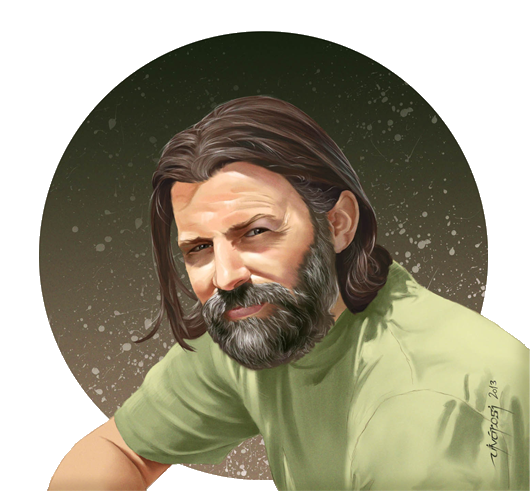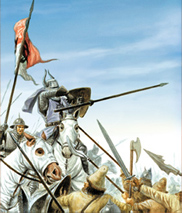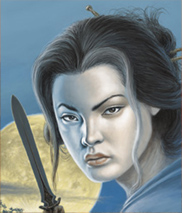 I've been a painter, illustrator and graphic artist for more than 15 years. I've been working mainly in the field of applied graphics. I've never been interested in advertising myself, because I think what you do and achieve is more important than business cards and a pile of leaflets. I might be wrong but the result of the15 years have proved me right in a way. I don't really remember times when I was bored. This is the case even today. A lot of things have changed in the past few years. New tools and styles were added to conventional techniques. Requirements have changed but one thing remained the same: you have to take into consideration that it is the client that has the last word. You should be artistically humble. Fortunately this has never caused any major problems for me. I no longer need to accommodate myself to conditions much. Clients ask me to work for them on the basis of my portfolio.
I've been a painter, illustrator and graphic artist for more than 15 years. I've been working mainly in the field of applied graphics. I've never been interested in advertising myself, because I think what you do and achieve is more important than business cards and a pile of leaflets. I might be wrong but the result of the15 years have proved me right in a way. I don't really remember times when I was bored. This is the case even today. A lot of things have changed in the past few years. New tools and styles were added to conventional techniques. Requirements have changed but one thing remained the same: you have to take into consideration that it is the client that has the last word. You should be artistically humble. Fortunately this has never caused any major problems for me. I no longer need to accommodate myself to conditions much. Clients ask me to work for them on the basis of my portfolio.

Tibor Szendrei was born in Debrecen, Hungary, on 18 February 1963. He says it all started at the age of ten, when he became interested in drawing. In spite of this he studied vehicle manufacturing and repairing, but interestingly, never worked in his trade. He was drawing instead. He confesses to be an autodidact developing through hard work and experience. He paints mainly book covers, but several magazines, including children's magazines have also asked him to make illustrations for them. His works can be seen on playing cards and board games, in addition, he has proved to be good at drawing concepts, too. He has worked for all the major Hungarian publishers, furthermore, in the mid '90s Heyne Verlag (Germany) published some of his magazine covers

"I've known Tibi from the beginning of his career. He was drawing comics at the time, working as a ad/graphic designer as well. He's been a freelance artist since 1988. Before 1988 he painted huge movie posters, worked as a factory worker, a paperboy, and a graphic designer. He worked in a zoo, and was out of job for a while. As he didn't like ties, he decided to start his own business. He has painted more than 500 covers, and innumerable colour and black-and -white illustrations since then. I'm grateful to him as a writer, too, since his graphics have played a significant role in illustrating my writings. Sometimes it was his work that determined the mood of my novel, as he finished his work earlier than me. Some of his paintings are so perfect that I can't stop looking at them." (John Caldwell, fantasy and sci-fi writer)
1. When did you decide to be a graphic artist?
When I was ten, I was selected to keep the class diary (about trips, parties, celebrations, etc.). I filled it with drawings. I think that was the time when I discovered my desire to draw. It took 15 years to realize what I really wanted to do. Then I started my own business as a graphic artist. After 4 years I was able to earn my living by drawing.
2. Why do you like drawing?
Creation is a source of pleasure, even if the result does not always match my expectations. Perceiving beauty, the unusual, seeing the visual laws of nature whereby my sight and memory develops; creating something eternal in an ever changing world, sharing this with others without having to talk about it too much - that's why I like drawing.
3. Did you have any teachers?
I didn't have any formal education apart from the art classes at school. I have learnt a lot from other artists' works. Experience has been my strictest teacher, the desire to learn my stimulus. I haven't been able to pass the exam in contentment so far.
4. What are your favourite themes?
I love drawing and painting everything that has something to do with nature. I like trees very much. The fewer ties there are, the more pleasure I have. I'm also interested in challenges. Genre is not really important in this respect, though themes related to mystery fire my imagination.
5. What are your working methods and techniques?
The first sketches are born in my mind, then I make some on paper. I draw the final version in graphite pencil. For colour pictures I usually use acrylic paints. After the necessary masking I paint the picture by brush or airbrush. The airbrush technique helps achieve fine surfaces, but of course I don't always want fine surfaces. So far I haven't used oil paints much, because compared to acrylic paints they dry slower, and it quite often happens that I have only a few days to paint a picture. Deadlines are the best inspiration for an illustrator. I have also taken to digital techniques, which I mostly use when I have to work in the evening.

6. Do you use models?
I used to ask people to model for me, but as my skills developed I no longer needed models. Now most of the time I draw from memory, but if necessary, I make use of every form of help. I have a collection of interesting pictures cut out from magazines as you can learn a lot from these. My shelves are full of coffee table books and books, and I have a camera too.
7. What size are your pictures?
In the case of paper pictures one side is never longer than 420 mm, the other side is always shorter than 300 mm. This usually corresponds to size A/3. Oil paintings are twice as big, but it takes four times longer to complete them. Book covers are ideally made in at least three times the size of the book itself, but I don't calculate like this, I use a smaller brush instead. Playing cards are usully 40-50 mm. You can't really make out the details in this size. I'd like to paint bigger pictures, but unfortunately Hungarian publishers don't pay for the additional expenses. The size of the picture has nothing to do with the fee, so we have to be economical as well. I wish it wasn't like that.
8. How long does it take for you to paint a picture?
In the case of acrylic pictures 3-7 days. The amount of time I spend on a picture depends on deadlines, themes and the fee. Everything is requested to be done quickly, cheaply and in top quality. I can simultaneously guarantee only two of these.
9. Are you given a free hand by your clients?
I like working only with clients who trust me. Trust should be mutual. I try to follow my own ideas keeping in mind my clients' requests. There were times when I accepted every kind of work. It was quite useful but I try not to remember some of the works I created that time.
10. What are the things you have to consider?
Publishers would like to sell as many books as possible. A good cover can help a lot. I have to paint a picture which is interesting and spectacular enough to make readers-to-be interested. It's good when the cover reflects the mood of the story. It's my strong desire to achieve this. Sadly, it's just impossible for me to read the books before illustrating them, so I consult either the writer or the editor before I start working. It goes for every kind of work. In spite of all these things I have the freedom I need.

11. How many book covers and illustrations have you made so far?
I stopped counting book covers at 400. A couple of years have passed since then. I have no idea how many other illustrations I have made.
12. Do you have any role models?
In my childhood French comics had a strong influence on me, at the same time I liked looking at the works of the classic masters too. In my twenties, I admired the works by Boros and Szikszai. I already felt that time I wanted to do something similar. Other influential artists include André Chéret, Frank Frazetta, Michael Whelan, Keith Parkinson, Alan Lee, John Howe. In fantasy Boris Vallejo's art made a major breakthrough. His refined techniques brought him and the genre immense popularity in the1970s. I became interested in fantasy because of his pictures. I could mention several artists painting fantasy today, which proves the increasing popularity of the genre.
13. Do you think of your work as art?
Every kind of activity can be done artistically, so can mine. I don't expect anyone to call me 'master', but I don't exclude myself from the company of artists.
14. What else would you like to achieve?
I almost exclusively paint for Hungarian clients. I feel it's time to open to the world, though I know it's not an easy thing to do. But of course the Hungarian market might reveal some secret opportunities as well.















